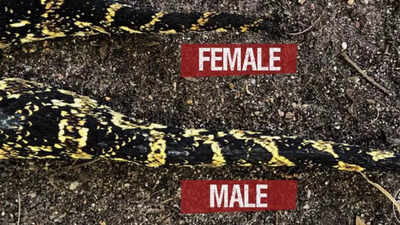
Source: African Snakebite Institute
Determining a snake’s gender is often challenging due to the subtle differences between males and females. Unlike mammals or birds, snakes rarely show obvious external sexual characteristics, making visual identification difficult.
Tail length, body size, and coloration can offer clues, but these traits vary widely between species and regions. For example, males of some species have longer, tapering tails, while females may be larger to accommodate egg development, but exceptions are common. The most accurate method for sexing snakes is hemipenis probing, which examines internal reproductive organs. Correctly identifying a snake’s gender is vital for breeders, conservationists, and enthusiasts, as it ensures proper care, effective housing, and successful breeding practices.
Understanding male and female differences in snakes
Sexual dimorphism refers to the physical differences between males and females of a species. In snakes, these differences are often subtle, and in many cases, they vary depending on the species or even the region in which the snake lives. Some species may exhibit differences in tail length, body size, or coloration, while others may show little to no external distinction. Tail length is commonly cited, with males often having longer, tapering tails, while females have shorter, stubbier tails.
Similarly, females of certain species may grow larger than males to accommodate egg development. Coloration can also serve as a visual clue in some species, but these traits are rarely universal and must be interpreted cautiously.A study by Sivan (2023) highlighted that sexual dimorphism in tail length, where males have relatively longer tails than females, is a common occurrence among snake species. However, this pattern is not consistent across all species, and exceptions exist.
How tail length helps identify male and female snakes
Tail length is often one of the first features herpetologists examine when attempting to determine a snake’s gender. In species such as the Puff Adder (Bitis arietans), males typically have longer tails than females. This difference can be striking when multiple individuals are compared side by side, but in isolation, it may be misleading. Some species do not follow this rule, and individual variation can further complicate matters.
While tail length provides an important clue, it should always be considered alongside other indicators, particularly when dealing with juveniles, whose tails may not yet reflect adult proportions.Research by Kane (2022) observed that in the Ethiopian Mountain Adder (Bitis parviocula), males have proportionally longer tails than females, a characteristic used for visual sexing.
Snake gender differences : Understanding coloration patterns
Coloration patterns can also offer insight into a snake’s gender, but these patterns are highly variable.
The Boomslang (Dispholidus typus) provides a clear example of this complexity. In parts of Africa, males are commonly green, while females are generally brown. However, in the Cape provinces, males may appear dark black with yellow, green, or orange sides. Juveniles, regardless of sex, often display greyish coloration with vivid emerald eyes.
This illustrates the challenge of relying solely on color for gender identification, particularly in species with regional variation or age-dependent coloration.A study by Marais (2020) noted that in the Cape provinces, male Boomslangs exhibit darker dorsal coloration with vibrant lateral hues, while females maintain a more subdued brown coloration.
How hemipenis probing accurately identifies snake gender
For definitive gender identification, herpetologists rely on hemipenis probing. This method involves gently inserting a metal probe into the snake’s cloaca and directing it toward the tail. In males, the probe typically extends beyond 10–12 tail scales, revealing the presence of hemipenes.
In females, the probe reaches less than three tail scales, indicating the absence of male reproductive organs.A comparative study by Tan et al. (2024) emphasized that probing is more reliable and efficient than contrast radiography for gender determination in reticulated pythons. The probing method proved to have 100% accuracy, outperforming contrast radiography, which only achieved 75% accuracy.
Juvenile snake gender: Why identifying males and females is difficult
Sexing juvenile snakes presents a unique set of challenges.
Young snakes often lack the pronounced tail length differences and coloration patterns seen in adults. Because of this, visual identification is often unreliable for juveniles. For breeders and conservationists, accurate juvenile sexing is essential for planning housing arrangements, diet, and breeding programs. In many cases, professional techniques such as probing or ultrasound imaging are required to establish the gender of young snakes accurately.A study by Borczyk et al. (2021) highlighted that juvenile fish-egg-eating snakes (Aipysurus eydouxii) exhibit minimal sexual dimorphism, making gender identification challenging without invasive methods.
Professional techniques for determining male and female snakes
Beyond tail length, coloration, and probing, other methods exist for identifying snake gender. Popping, for instance, involves manually everting the male hemipenes and is primarily used for small snakes. Ultrasound imaging can non-invasively reveal internal reproductive organs. Behavioral observation, particularly during breeding season, can sometimes indicate gender through courtship behaviors. However, these methods are generally reserved for professionals or advanced keepers due to the skill and experience required.A review by Vetere (2025) discussed various methods for sex determination in reptiles, emphasizing the importance of selecting appropriate techniques based on the species and individual circumstances.Also Read | Meet Mani Amma, 74, who holds 11 driving licenses and drives a Rolls-Royce Ghost effortlessly—you won’t believe what else she can drive!

